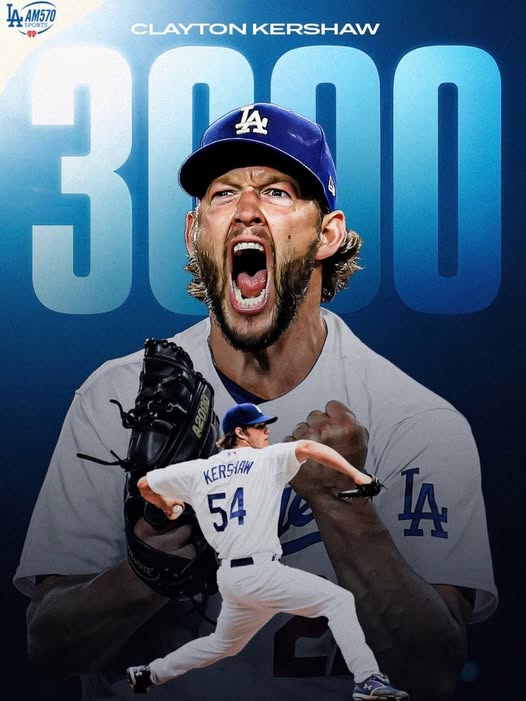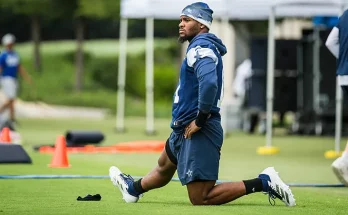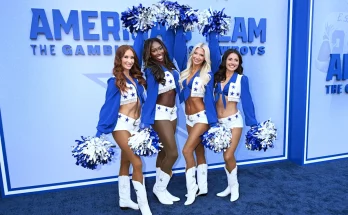In a career that has been nothing short of historic, Los Angeles Dodgers ace Clayton Kershaw has once again etched his name deeper into baseball lore. On a warm summer night in front of a roaring home crowd at Dodger Stadium, the three-time Cy Young Award winner reached yet another monumental milestone—his 3,000th career strikeout, becoming only the 20th pitcher in Major League Baseball history to do so.
For over a decade, Kershaw has been the face of the Dodgers’ pitching staff, a model of consistency, competitiveness, and elite-level dominance. With his signature curveball, pinpoint control, and unmatched intensity on the mound, Kershaw’s path to 3,000 strikeouts has not only reflected his personal greatness but has also symbolized a golden era for Los Angeles baseball.
The Road to 3,000
Kershaw’s journey to this rarefied club didn’t happen overnight. Drafted seventh overall in the 2006 MLB Draft out of Highland Park High School in Texas, the left-hander made his MLB debut at just 20 years old in 2008. From the start, his command and presence were unmistakable. What followed was a stretch of dominance rarely seen in the modern era.
His breakout year came in 2011, when he won his first Cy Young Award, leading the National League in wins (21), ERA (2.28), and strikeouts (248). It was the beginning of a remarkable run that saw him win three Cy Young Awards in four seasons (2011, 2013, 2014), an MVP award in 2014, and multiple ERA titles.
Unlike some power pitchers who rely solely on velocity, Kershaw’s success has been built on deception, command, and intelligence. His curveball, famously described by Vin Scully as “Public Enemy No. 1,” has baffled hitters for years, while his slider became a late-career weapon that helped him remain dominant even as his velocity dipped.
In a sport that often sees flameouts and injuries derail promising careers, Kershaw has remained resilient. Though back injuries and age have forced adjustments in recent years, he has continued to produce at an elite level, carefully managing innings while still overpowering hitters with his guile.
Historic Context
Reaching 3,000 strikeouts places Kershaw in truly elite company. He joins a list that includes legends like Nolan Ryan, Randy Johnson, Roger Clemens, Greg Maddux, and Tom Seaver. It’s a club that demands both excellence and longevity—two hallmarks of Kershaw’s career.
What’s especially impressive is the pace at which he reached this milestone. Kershaw achieved 3,000 strikeouts in fewer innings than some of the greats ahead of him, including Maddux and Don Sutton. And unlike pitchers from previous generations who were allowed to rack up high pitch counts and complete games, Kershaw achieved this mark in an era defined by bullpen specialization and pitch-count limits.
Among left-handed pitchers, only Randy Johnson, Steve Carlton, CC Sabathia, and Tom Glavine have reached this mark. Kershaw now stands proudly beside them, further bolstering his case as one of the greatest southpaws to ever toe the rubber.
The Icon of a Generation
Clayton Kershaw isn’t just a statistical marvel—he’s a symbol of sustained excellence, discipline, and class.
For over 15 years, Dodgers fans have watched him take the mound every fifth day with a singular focus. His pre-pitch rituals, the intense stare into the catcher’s mitt, the classic windup, and the unflinching demeanor have become part of baseball’s collective memory.
He’s never been a loud self-promoter. His quiet, humble demeanor off the field contrasts beautifully with the fiery competitor he becomes on it. He’s a leader in the clubhouse, a mentor to younger pitchers, and a role model throughout the league.
And, of course, there’s the emotional weight of what this milestone means for Kershaw and Dodgers fans alike. For years, he bore the weight of postseason shortcomings, with critics pointing to his playoff performances as a blemish on his résumé. But that narrative changed with the 2020 World Series, where Kershaw played a vital role in delivering the Dodgers their first title in 32 years. That championship didn’t just silence doubters—it solidified his status as one of the game’s most complete and accomplished players.
The 3,000th Strikeout Moment
When the fateful moment arrived—strikeout number 3,000—Dodger Stadium erupted in a roar that seemed to shake the foundations of Chavez Ravine. Kershaw, never one to bask in the limelight, simply smiled and tipped his cap to the crowd, his teammates pouring out of the dugout to embrace him. It was an unforgettable moment, not just for Kershaw, but for baseball itself.
Fittingly, the strikeout came on a devastating breaking ball—a pitch Kershaw has mastered like few others in history. The batter swung helplessly, as so many have before. The scoreboard flashed the milestone. The fans stood. The baseball world watched in awe.
Social media lit up instantly. MLB icons, current stars, and fans from every corner of the globe sent congratulations. Dodgers manager Dave Roberts summed it up best in the postgame presser:
“We’re watching a legend, and we shouldn’t take it for granted. What Clayton does, day in and day out, is special. To reach 3,000 strikeouts—only the best of the best do that.”
Legacy Cemented
In the pantheon of Los Angeles Dodgers greats—names like Sandy Koufax, Don Drysdale, Fernando Valenzuela, Orel Hershiser, and Don Sutton—Clayton Kershaw now sits comfortably among, and perhaps above, the finest. He holds or is near the top in nearly every major statistical category for the franchise, and with this latest achievement, he has added yet another exclamation mark to an already glittering résumé.
His career totals now include:
- 3,000+ strikeouts
- Over 200 career wins
- A lifetime ERA under 3.00
- Multiple All-Star appearances
- Three Cy Young Awards
- One MVP Award
- One World Series Championship
Few pitchers, even among Hall of Famers, can match that combination.
Kershaw’s influence extends beyond the diamond. His charity work—particularly through his foundation “Kershaw’s Challenge”—has impacted communities in Los Angeles, Zambia, the Dominican Republic, and his native Texas. His commitment to humanitarian causes, family, and faith has made him an ambassador for the sport.
What’s Next for Kershaw?
At 36 years old, Kershaw continues to defy the odds. While he’s no longer the dominant flame-thrower of his early years, his pitch sequencing, game preparation, and mental toughness keep him among the league’s most effective pitchers.
Could he reach 3,500 strikeouts? That would depend on health, workload, and desire. Kershaw has often spoken about taking things year by year, especially as family considerations come into play. But for now, he remains a vital part of the Dodgers’ rotation and a crucial voice in the clubhouse.
Whether or not he chooses to pitch for several more seasons or retires soon, his place in baseball history is secure. His Hall of Fame induction is all but guaranteed—and will likely be a unanimous one.
A Moment for Baseball Itself
In an era where power hitting and launch angles dominate the headlines, milestones like this remind fans of the artistry of pitching. Kershaw’s 3,000th strikeout isn’t just a personal achievement—it’s a celebration of the pitcher’s craft, a testament to perseverance, and a symbol of baseball’s enduring beauty.
As the game continues to evolve, it’s players like Clayton Kershaw who remind us why we fell in love with baseball in the first place. The quiet intensity, the battles between pitcher and hitter, the pursuit of greatness over a long career—Kershaw embodies it all.
Final Thoughts: A Living Legend
Clayton Kershaw’s 3,000th strikeout is more than a statistic. It’s a reflection of a career defined by excellence, integrity, and a relentless drive to compete. It’s a moment that Dodgers fans—and baseball fans—will cherish forever.
And while we celebrate this achievement, we’re reminded that greatness is rare, and we are fortunate to witness it in real time.
Clayton Kershaw is not just one of the best pitchers of his generation—he’s one of the greatest to ever play the game.
So here’s to No. 22—the curveball maestro, the heart of the Dodgers, and now, a permanent member of baseball’s 3,000-strikeout club.



